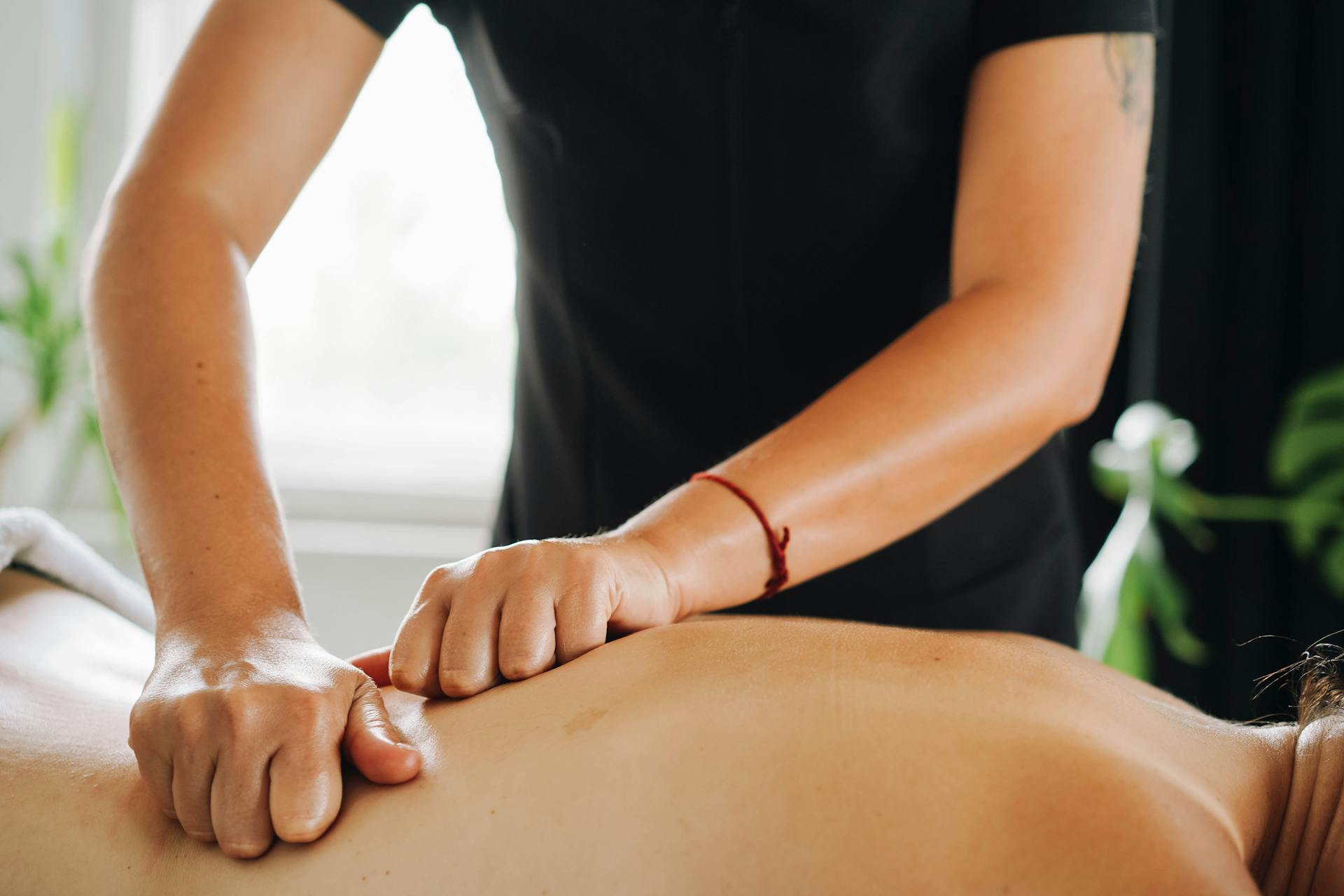If you’re one of the 18-26% of people living with shoulder pain, you know all too well how it can turn everyday tasks — from lifting your groceries to reaching for the remote — into a struggle.
When this pain comes from shoulder tendonitis (or inflammation of the shoulder tendons), the simplest remedy is to take a break from any activities that strain the joint. But if you’re looking for more ways to ease pain and boost recovery, could massage therapy help?
Learn about shoulder tendonitis massage below, including the benefits, techniques, and what to keep in mind before starting.
What Causes Shoulder Tendonitis?
In most cases, shoulder tendonitis (also written tendinitis) stems from overuse or repetitive strain that happens over a period of days, weeks, or even months. As time goes on, this kind of strain can cause damage and scar tissue to build up, leading to pain and limiting range of motion. And because it’s often tied to everyday activities — like your workout routine or job — it can be tricky to manage.
The most common triggers behind shoulder tendonitis are usually repetitive throwing or overhead motions. But it can occur due to anything that “overloads” the tendons improperly, which can cause microtears and damage over time. And while it’s often a chronic issue, it can also happen suddenly — like after a fall or direct hit to your shoulder.
Symptoms
When you have shoulder tendonitis, you might notice symptoms like:
- A dull ache radiating from your shoulder
- Worsening pain at night
- Pain when rotating your shoulder in certain directions
- A clicking noise in the shoulder joint
- Muscle stiffness or loss of flexibility
- Mild swelling or redness
Who Gets Shoulder Tendonitis?
Everyone from athletes to those with certain kinds of jobs can wind up with overuse-related shoulder tendonitis. Specifically, it often affects swimmers, boxers, weightlifters, volleyball players, and racket sports players. But it also commonly shows up in workers who spend a lot of time reaching above their heads — like construction workers, cleaners, painters, and mechanics.
Types of Shoulder Tendonitis
Your shoulders contain countless moving parts, all working together to give them the widest range of motion of all joints in your body. Your rotator cuff tendons and your biceps tendons meet in this area, meaning that there are two main types of tendonitis that typically affect the shoulder:
Biceps Tendonitis
Your biceps tendon stretches from your elbow all the way to your shoulder joint, with the “long head” of the tendon connecting your biceps muscle to your shoulder socket.
This type of tendonitis often comes with pain that you feel in the front of your shoulder. Sometimes, you might also notice a dull ache radiating down your upper arm bone.
Rotator Cuff Tendonitis
The rotator cuff is a set of muscles and tendons that connect your upper arm bone to your shoulder blade. When the rotator cuff tendons are inflamed or injured, you’ll most likely feel it on the upper outer part of your shoulder joint.
Up to one-third of older adults with this type of tendonitis also have a rotator cuff tear, so it’s important to check with your doctor if you notice any weakness alongside the pain.
What To Know Before Trying Massage
When you have an ache or pain, it’s only natural to want to massage it away. But the truth is that with shoulder tendonitis, your best first step is to ease off any painful activities and simply give your body some time to rest. Once the initial inflammation calms down, massage can often be a helpful tool for easing pain and promoting long-term mobility.
With that in mind, here’s what to know before you try shoulder massage:
- Steer clear from massaging any areas that are freshly inflamed or injured.
- Talk to your doctor to see when massage can best fit in your timeline.
- Stick with pressure levels and techniques that feel good and ease pain. If massage isn’t bringing some relief after 20–30 seconds, it could be a sign that your tendons need more time to heal.
Benefits of Massage for Shoulder Tendonitis
Massage can be a wonderfully soothing part of any shoulder self-care routine — but what kind of positive effects can you expect for shoulder tendonitis? Some main benefits may include:
Better Range of Motion and Mobility
Healing from shoulder tendonitis doesn’t just mean reducing aches and pains, but also getting your shoulder joint back to normal range of motion again. The good news is that massage therapy can help soothe tight muscles and break up trigger points that may be limiting your movement — making it an excellent option for supporting your flexibility while you heal.
One 2017 review of studies found that massage boosted shoulder flexion – or the ability to move your shoulder up in front of you — as well as abduction, or rotating your shoulders up and out to the side.
Promotes Healthy Blood Flow for Recovery
A gentle massage to the shoulder can be a great way to promote friction and warmth, both of which can help boost healthy circulation. In turn, it can mean more oxygen and nutrient-rich blood flow to the tendons and muscles around the joint.
Pain Relief
Another key benefit of massage for shoulder tendonitis? Pain relief. After the initial inflammation stage is over, massage can be a powerful remedy for easing tension and discomfort around the shoulder.
It works in a few main ways: first, the direct pressure can soothe the muscles and stimulate pressure receptors, which can affect the way we perceive pain. It can also promote feel-good endorphins and relieve stress — two benefits that can also ease sensations of pain.
In one 2017 review of studies, researchers found that massage seemed to be helpful for many types of shoulder pain, although more research is needed to know exactly which techniques are best for each type of condition.
How To Try Massage for Shoulder Tendonitis: 3 Ways

If you’re curious about adding shoulder massage into your recovery routine, here are three simple self-massage techniques to know about:
Note: Be sure to talk to your doctor before trying shoulder tendonitis massage, as it may not be a good fit for everyone at every stage of recovery.
Simple Cross-Friction Massage
A technique often used by physical therapists and massage therapists, cross-friction massage involves applying pressure across tendon and muscle fibers, with the goal of breaking up scar tissue and adhesions around the tendons.
Here’s how to try it:
- Sit with aligned yet comfortable posture.
- With your affected arm, bend your elbow at 90 degrees, and place your hand behind your back.
- Using two fingers from your opposite hand, begin to massage outward from the collarbone to the shoulder joint with gentle, gliding pressure.
- Palpate (or feel) around your shoulder until you find the tender area.
- Place one finger on top of the other, and massage the spot with moderate pressure in short side-to-side motions.
- After 20–30 seconds, the tenderness should slightly subside. (Tip: If it doesn’t improve or gets worse after 30 seconds or so, stop. Your shoulder may need more healing time before it’s ready for massage.)
To see this massage in action, check out this physical therapist tutorial video, complete with the technique and a few more tips for relief.
All-Over Shoulder Massage
For broad relief, a gentle self-massage to the biceps, triceps, and rotator cuff muscles can be an excellent option. To try it:
- Take a deep breath, and use your opposite hand to begin lightly massaging your affected shoulder in large circular motions. This is called effleurage, and it helps to warm up the muscle tissue.
- Next, use your fingers to massage outward from the center of your chest toward the front of your shoulder. Repeat for 1–2 minutes. (Tip: Feel free to use your knuckles for a deeper massage here.)
- Then, it’s time to focus on the upper arm. Use gentle kneading or squeezing motions to massage along the biceps and triceps for 30–60 seconds each.
- Cross your hand up over your back, and repeat the kneading motions along the large muscle between your neck and shoulder (your trapezius muscle) for 1–2 minutes more.
- Optional: If you can reach a little further, feel free to massage the muscles closer to the shoulder blade for an additional 30–60 seconds.
Ice Massage
When you need to curb inflammation, ice massage can be a great remedy to try. It involves applying something really cold (like ice) to your shoulder for a few minutes to soothe pain and inflammation.
Rather than placing an ice cube directly on your shoulder, one of the best ways to try it is to freeze some water in a small paper cup, like a dixie cup. Once frozen, you can tear off a piece of the cup to expose a small part of the ice while still having the rest of the cup as your “handle.”
Then:
- Locate the tender area on your shoulder.
- Use the exposed ice to massage the spot in side-to-side motions.
- Repeat for 2–4 minutes. (Tip: Massage for no longer than five minutes to avoid any irritation to the skin.)
What About Professional Shoulder Tendonitis Massage?
If your lifestyle or job has taken a toll on your shoulders — or your body as a whole — you might be interested in trying professional massage. Paired with regular self-massage, a pro therapist can use techniques that target underlying issues and imbalances that might be adding to your discomfort. They can also offer more personalized self-massage tips, help support healthy shoulder mobility, and improve your recovery in the long run.
Some options for professional massage include:
- Sports massage, which involves a blend of massage techniques and stretches to prevent injury, promote recovery, and optimize mobility
- Swedish massage, which is great for all-over relaxation and relief
- Trigger point therapy to target tight, irritable bands of tissue that may be causing pain or stiffness
Sometimes, if you’re prescribed physical therapy for tendonitis, your therapist might use a type of manual therapy called soft tissue mobilization (STM) in your sessions. Unlike standard massage, this technique is often used as part of medical treatment plans for more serious injuries.
Other Tips for Shoulder Tendonitis Relief
Aside from adding massage to your self-care routine, here are some other key steps that can make a positive difference in tendonitis recovery:
RICE Method
The RICE method (also known as rest, ice, compression, and elevation) is often the first-line treatment for mild overuse injuries. The goal? To reduce swelling and inflammation so that you can focus on longer-term healing.
It’s often an essential first step before introducing other recovery tools (like massage and stretching) into your routine. Ice soothes inflammation while rest gives your body a chance to repair damaged tissue. At the same time, both elevation and compression help promote healthy blood flow to the injured area.
Exercises for Strength and Mobility
While tendonitis recovery starts with activity modification and rest, staying moving is equally as important later on. Once you’re outside of the acute phase of tendonitis, the right exercises can help you:
- Strengthen the muscles that support the tendons — as well as the tendons themselves
- Promote healthy blood flow in and around the joints
- Reduce stiffness while boosting your shoulders’ range of motion
As always, it’s important to check with your doctor before adding new exercises to your routine, especially if you have an acute case of tendonitis. Once you have the go-ahead, here are some simple yet powerful exercises to try:
Shoulder Squeezes
When you have poor posture, it can cause upper back muscles (including the trapezius and rhomboid muscles) to become weakened and fatigued. And in the long run, this can become a major source of strain on the shoulder tendons.
Fortunately, a simple exercise called shoulder squeezes can help address this. Here’s how to try them:
- Bend your elbows at a 90-degree angle, and raise your arms out to your sides. Your hands should be pointed straight in the air.
- Keep your arms in position and squeeze your shoulder blades together to bring your elbows backward.
- Hold for 5–10 seconds, and slowly return to the starting position.
- Repeat 10–20 times. (Tip: To maximize the benefits, feel free to sprinkle this exercise in all throughout the day. Not only will it strengthen your back muscles, but it can help remind you to stay in better posture more often.)
Shoulder Table Glides
Shoulder table glides involve gently rotating your shoulder with the help of a table or desk. It works by engaging many of the muscles involved in shoulder flexion — while using gravity to relieve some of the pressure. Here are the steps:
- Sit parallel to a table or desk that has enough space for you to fully extend your arm.
- With your arm bent, rest your elbow and hand on the table.
- Slowly lean forward, gliding your arm in front of you until you feel a stretch in the shoulder.
- Hold for 3–5 seconds. Then, glide back up into the sitting position.
- Tip: This should feel like a soothing, passive stretch, so be sure to stop if you feel any discomfort or pain.
- Repeat a few times per day as needed.
Habit and Lifestyle Changes
Adjusting your daily activities to be more shoulder-friendly is another great step in relieving tendonitis pain — and preventing it in the future. Some helpful lifestyle changes might include:
- Practicing better posture in your day-to-day
- Changing your exercise routine to reduce overhead lifting, focus on mobility work, and gently strengthen the rotator cuff
- Talking to your boss about adjusting your work activities
- Being more mindful about giving your shoulder breaks throughout the day
The Takeaway
The shoulder is one of the hardest-working and most complex joints in your body — and it’s why it can be a hotspot for tendonitis pain. The good news is that when used at the right point in your recovery, massage may be able to soothe discomfort, boost blood flow, and keep your shoulder moving comfortably.
If your shoulder feels especially tender or inflamed, it’s important to give it time to heal before adding massage into your routine. When you have the OK from your doctor, you can try techniques like cross friction, ice, or simple upper body massage for some extra relief.
Looking for an easier way to massage your shoulders at home? The expert-trusted tools from MedMassager can help. Pick up the MedMassager Body Massager Plus today, or learn more about how to use it here.



